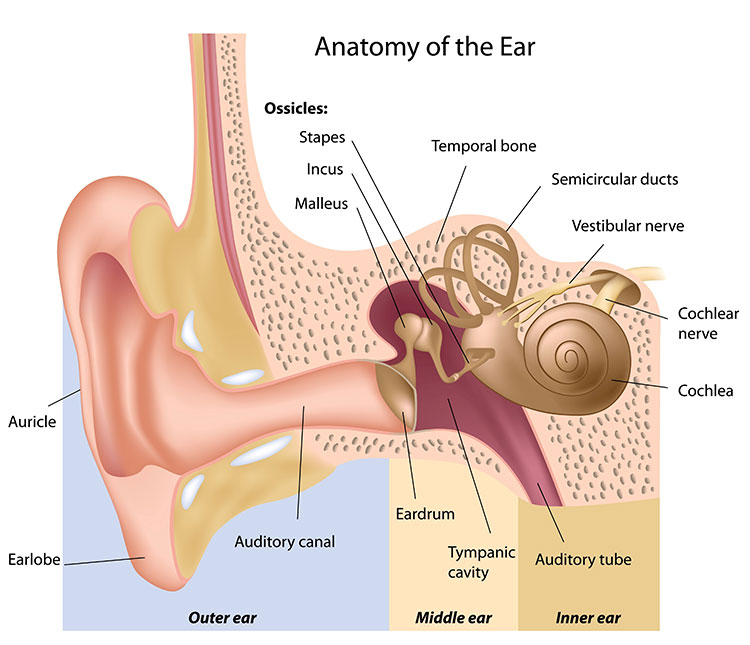This website uses cookies so that we can provide you with the best user experience possible. Cookie information is stored in your browser and performs functions such as recognising you when you return to our website and helping our team to understand which sections of the website you find most interesting and useful.
How Hearing Works
How hearing works is a highly sophisticated and robust system of the hearing mechanism in the human body. The ear controls hearing and balance and comprises three parts–the outer, the middle, and the inner ear. All three parts of the ear are essential for detecting sound, working together to move sound from the outer ear through the middle ear and into the inner ear.

Sound is Transformed From Pressure Waves
Sound is transformed from pressure waves in the environment to mechanical energy. Through electrochemical reactions, this mechanical energy is transformed into something that the brain recognizes as music, warning signals, sounds of nature, and meaningful conversation.
Parts of the Ear
Outer Ear. The Outer Ear funnels the sounds around us down to the eardrum. The outer ear is made up of the pinna (the ear you see) and the ear canal. They act as resonators, which amplify certain pitches or frequencies of sound before they reach the eardrum.
The part of the outer ear that we see is the pinna or auricle. With its grooves and ridges, the pinna provides a natural volume boost for sounds in the 2000 to 3000 Hz frequency range, where we perceive many consonant sounds of speech.
The ear canal (or external auditory meatus) is the other important outer ear landmark. The ear canal is lined with only a few layers of skin and fine hair, and it is a highly vascularized area. This means that there is an abundant flow of blood to the ear canal. Earwax (cerumen) accumulates in the ear canal and serves as a protective barrier for the skin from bacteria and moisture. Earwax is normal unless it completely blocks the ear canal.
Middle Ear. The eardrum (or tympanic membrane) is the dividing structure between the outer and middle ear. Although it is an extremely thin membrane, the eardrum comprises three layers to increase its strength.
The ossicles are the three tiny bones of the middle ear located directly behind the tympanic membrane. These three bones form a connected chain in the middle ear. One of the bones is embedded in the innermost layer of the tympanic membrane, and the third bone is connected to a membranous window of the inner ear. The ossicles take mechanical vibrations received at the tympanic membrane into the inner ear.
The Eustachian tube is the middle ear’s air pressure equalizing system. The middle ear is encased in bone and does not associate with outside air except through the Eustachian tube. This tubular structure is normally closed, but it can be involuntarily opened by swallowing, yawning, or chewing. It can also be intentionally opened to equalize pressure in the ears, such as when flying in an airplane. When this happens, you might hear a soft popping sound.
The Middle Ear is where the sound is changed from pressure waves to mechanical energy. The eardrum is made of layers of skin, which are stretched tight like the top of a drum. As sound enters the ear canal, the eardrum begins vibrating. Three tiny bones called the Hammer (Malleus), Anvil (Incus), and Stirrup (Stapes) are attached to the eardrum. Their job is to transfer the vibration of the eardrum to hydraulic waves in the inner ear.
Inner Ear. The inner ear is an organ located deep within the temporal bone, which is the bone of the skull on both sides of the head above the outer ear. The inner ear has two main structures: the semicircular canals and the cochlea:
- Semicircular Canals. These structures do not contribute to hearing, but they assist in maintaining balance as we move.
- Cochlea. This is the hearing organ of the inner ear, a fluid-filled structure that looks like a snail. The cochlea changes the mechanical vibrations from the tympanic membrane and the ossicles into a sequence of electrical impulses. Sensory cells, called hair cells, bend in the cochlea as mechanical vibrations disrupt the fluid. This bending of the hair cells causes electrical signals to be sent to the brain by way of the auditory nerve and up to the brain, where they are interpreted as sound. The cochlea is arranged by frequency, much like a piano, and encodes sounds from 20Hz (low pitch) to 20,000Hz (high pitch) in humans.
Sound waves reaching the outer ear cause the eardrum to vibrate. The vibrations are passed on from the middle ear to the inner ear. Fine hair cells in the cochlea play an essential role in converting sound waves into electrical signals.
Hearing and How It Works
Check out this video on Hearing and How It Works –it further illustrates how sounds travel from the ear to the brain, where they are interpreted and understood.
Contact Us
If you notice any changes to your hearing, contact Advanced Audiology Care at (848) 231-6637 to make an appointment with Dr. Fan. During your appointment, he will perform a comprehensive hearing test and offer treatment recommendations that best meet your needs and lifestyle. You can also request an appointment online.
Hearing FAQs
- Turn the Volume Down When Listening to Music or Watching TV
- Avoid Prolonged Exposure to Loud Noises
- Wear Protective Hearing Devices (e.g., Earplugs, Earmuffs) in Noisy Environments
- Get Your Hearing Checked Regularly
- Use a Washcloth to Clean Your Ears (Avoid Using Cotton Swabs)
- See a Professional to Remove Excess or Impacted Earwax


